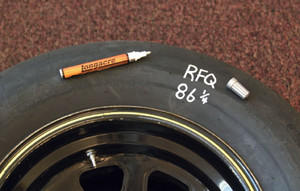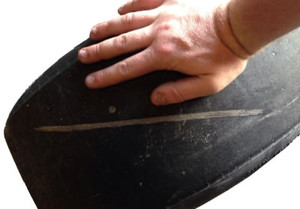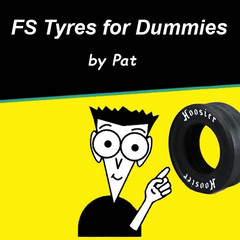I had a phone call today from a team member who wanted to talk about tyres.
He made the point that there is a lot of tyre information out there, including the data from the Tyre Testing Consortium, but little to tell you what it means in the real world.
His first question was about the practical difference between radial ply and bias ply tyres, He pointed out he knew about the constructional differences, but what difference did it make on the track and in his design of the car.
As we spoke, it became clear to me that he could not be the only student competitor out there who was confused by this. So, here is Pat's 'Tyres for Dummies' advice, and I promise not to use the word 'pacejka' even once. Oops, I just did!
First, bias ply and radial ply tyres.
Bias ply tyres have stiffer sidewalls and softer tread base than radials. This means they are more sensitive to camber changes. The stiff belt in a radial allows the tyre to camber more whilst still keeping the tread flat to the track surface. Essentially, this means that less camber recovery is needed in suspension design.
Camber recovery is a conundrum! Sufficient camber recovery in roll means excessive camber change when the vehicle dives or squats when braking or accelerating, to the detriment of performance.
The radial tyre will accept more static camber, as the sidewall flex will allow the tread surface to remain flat at camber angles that would have the softer tread area in a bias ply tyre 'peeling' off the surface. This makes the choice of suspension geometry easier for the designer.
This sounds like radials are 'better' than bias tyres, but it is not so clear cut. The softer radial sidewalls give the tyres their own characteristics.
Radials are more sensitive to pressures. Because the soft sidewalls contribute less to the tyre 'spring rate', care should be taken to ensure consistent pressures. This is a good reason to use dry nitrogen to inflate them, or at the very least, to ensure the air used is dry.
Low pressures and radial tyres take something away from steering feel and precision. This is because the wheel is able to turn 'inside' the tyre when steering is first input. This can be reduced by setting some static toe-in or toe- out, so the tyre is already 'loaded' before any steering is input. Whether toe-in or toe-out and how much is better is a discussion for another time.
Sidewall flexibility will also permit the wheel to partially 'push through' the tyre under lateral forces. On the loaded outside front wheel, this will reduce the scrub radius. If the designer has chosen a small scrub dimension, or listened to some pundits who champion 'centre point steering', the scrub radius will go negative, to the detriment of steering feedback.
The soft sidewall/stiff tread base of radials makes them 'breakaway' more suddenly than bias tyres, although this breakaway may happen at slightly higher lateral loads (remember the bias ply tyre 'peeling' off the track surface?). This means that an expert driver may be faster on radials, but a less skilled driver may well be able to lap faster on bias tyres because their performance is more benign at the limits of adhesion.
Finally, radials will usually last longer than bias tyres, all other things being equal (which, of course, they are not!)
Next, mounting and inflating tyres
Tyres are best fitted by a professional using a tyre fitting machine. Forcing tyres onto the rim by enthusiastic amateurs using brute force and tyre levers can damage both the tyre and the wheel. Damage to the tyre bead or the seating area of the rim can result in a slow leak.
The common practice of lubricating the bead area with soapy water may well be okay for wheelbarrow wheels, but should not be used on your race tyres. Grease or other petrochemicals may stay on the tyre and cause it to slip on the rim under acceleration or braking. This is not so important with tubeless tyres, however, wheel balance will be lost if the tyre slips on the rim. Liquid soap makes a good fitting lubricant.
When fitting the tyre, only enough air pressure should be used to pop the tyre out onto the rim. There will be a maximum pressure listed on the sidewall and this pressure should NEVER be exceeded. Not because the tyre is likely to blow up, but because the cords in the carcass are likely to stretch, ruining the tyre shape. I have seen wheels split when overinflated, especially if there is some corrosion present. Wheel shrapnel can really ruin your day! Ideally, tyres should be inflated inside a safety cage.
 Speaking of 'carcass stretch', when I was racing seriously, I always measured the tread circumference of every tyre as I bought them and only ever accepted pairs matched within a couple of millimeters. Radials are usually pretty uniform, but bias tyres can vary quite a bit and their circumference can also change according to inflation pressure. Professional teams mark every tyre with its position on the car and its circumference. The Indycar tyre pictured has been marked as the Right Front Qualification tyre and is 86¼" around the tread.
Speaking of 'carcass stretch', when I was racing seriously, I always measured the tread circumference of every tyre as I bought them and only ever accepted pairs matched within a couple of millimeters. Radials are usually pretty uniform, but bias tyres can vary quite a bit and their circumference can also change according to inflation pressure. Professional teams mark every tyre with its position on the car and its circumference. The Indycar tyre pictured has been marked as the Right Front Qualification tyre and is 86¼" around the tread.
The tyre should be inflated only with dry air or nitrogen, as mentioned earlier. If they have been fitted by a 'garage down the road', it is likely the apprentice has not drained the compressor tank since last Christmas and the air will be wet! A professional tyre shop will purge and inflate them with nitrogen for a small charge. Do this!
Water in the air causes big pressure fluctuations as the tyre heats up, making control of operating pressure almost impossible. Wet air will also corrode the wheels, especially if they are made from a magnesium alloy. Dry nitrogen is very stable and pressures vary little as the tyres heat up. This permits teams to choose a more effective starting pressure for short events like the Autocross without having pressure management difficulties in the longer endurance event. It also makes choosing a suitable pressure easier when the ambient or track temperatures change.
Finally, balance. Wheel and tyre assemblies should be dynamically balanced after the inital 'settling' run. Out of balance wheels may not upset the driver but it sure does upset the contact patch. The secret to having good 'mechanical grip' is to avoid disturbing the tyre to road interface. This is particularly important when running in wet conditions like the FSG skidpan event.
Professional teams mark every tyre with its position on the car and its circumference. The Indycar tyre pictured has been marked as the Right Front Qualification tyre and is 86¼" around the tread.
Third, getting the best from the tyres.
As you have been told a thousand times, tyre choice is the most important decision made about your car and their condition defines your performance capabilities. So they need to be carefully looked after.
Real rubber disappeared from tyre manufacture a long time ago. These days 'rubber' is another petrochemical product. Various 'plasticisers' are used to keep the tyre rubber grippy. As they leach or evaporate from the tread, so the grip deteriorates.
Heat evaporates the plasticisers and partially 'vulcanises' the tread compound and hardens it. For this reason, each time the tyre is used or 'heat cycled' the available grip deteriorates. It may well be that a tyre reaches the end of its competitive life well before the tread is worn out!
A very good practice is to give tyres one mild heat soak before they are used for competition. The car should be driven at a reasonable pace for about 5 minutes without skidding or sliding on the tyres. This has several benefits. It stabilises and settles the carcass and tread compound.
The tread area should be covered or protected whenever the car is off the racing surface.
After each use, the tyres should be deflated (the refrigeration effect of the pressure reduction quickly cools them) and put away in a cool dark place to settle for at least 24 hours. This is called 'resting the tyres'. Racing on 'sticker' tyres will shorten their effective life with little positive benefit to lap times. That might suit professional race teams with unlimited budgets, but I can't think of any Formula Student teams that enjoy this benefit.
Race tyres traditionally are designed to operate best at about 100° to 120°C, but the soft compounds designed for lighter cars and shorter distances as used on Formula Student cars, generally offer best performance at a lower temperatures. Overheating the tyres will quickly wreck them, so it is the responsibility of the driver to monitor this. Tyres operating close to their upper temperature limit get a black, sooty look. This can be seen from the sidelines but is most easily seen by the driver, especially on the front wheels. Formula Student cars generally tend towards understeer, so the situation will most probably occur first at the front of the car.
If this situation does occur, the driver should ease off on the tyres, otherwise they will quickly 'go away' and are ruined for further use. If this is an issue in testing and the team can not address the problem by changing the setup, then a move to a slightly harder compound should be considered. Rest assured, there is such a thing as a 'too fast tyre'!
 When storing wheels or tyres for longer periods, the following precautions should be taken. Deflate mounted tyres and place each wheel or demounted tyre in a black bin bag. Squeeze most of the air out and seal the bag. Then store them in a cool dark place until required again. Ozone quickly attacks the rubber, so they should never be stored near a source, such as an electric motor or welding equipment.
When storing wheels or tyres for longer periods, the following precautions should be taken. Deflate mounted tyres and place each wheel or demounted tyre in a black bin bag. Squeeze most of the air out and seal the bag. Then store them in a cool dark place until required again. Ozone quickly attacks the rubber, so they should never be stored near a source, such as an electric motor or welding equipment.
At the track, teams should have two tyre specific tools, an accurate pressure gauge and a tyre pyrometer.
Pressures should be measured and recorded before and after each run. Excessive pressure increase will point to setup problems as much as temperatures measured across the tyre, but will also highlight such issues as wet inflation air or a tyre operating at its upper limit,
The pyrometer should be used every time the car comes off the track and the temperatures measured in three places across the tread of all four tyres. These temperatures will highlight issues with incorrect pressures and/or setup errors in camber or toe.
An infra red pyrometer is virtually useless for tyre performance analysis because the temperature of the tread surface is meaningless. It will cool rapidly before it can be measured and in any case, it is the temperature of the tread compound that interests us. This requires a proper needle type pyrometer!
Design Error of the month.
 This picture was recently posted on FSAE.com and promoted a robust discussion, not all about tyres.
This picture was recently posted on FSAE.com and promoted a robust discussion, not all about tyres.
The tyre is worn out. Long before it reached this stage, the heat cycled compound would have lost grip and the tyre would only be suitable for initial driver training or giving guests of the team 'test drives'.
Nothing is more counter-productive than trying to optimise the car setup on old tyres. The setup will be biased more and more towards improving grip on deteriorating rubber.
Then, when fresh new tyres are fitted, the car will try to tie itself in knots and can very quickly overheat and ruin the new rubber!
Tyres are expensive, I know, but setting up on hard old tyres is an exercise in frustration!
'Tyre softener', so beloved of karters, will not bring old, hard tyres back to life. Nor will it make new tyres even stickier, despite what it may say on the tin! There may be a slight temporary improvement in the performance of tyres that are part way through their life, but in my experience, this one small improvement really kills the tyres after only one more heat cycle and all the 'tyre softener' in the world will not bring them back. These treatments may also contain substances that are injurious to your health. Save your money!
So, that is the dummies guide to tyres and how to get the best from them. And I didn't mention pacjeka. Oh, there I go again.
Til next time...
Pat


